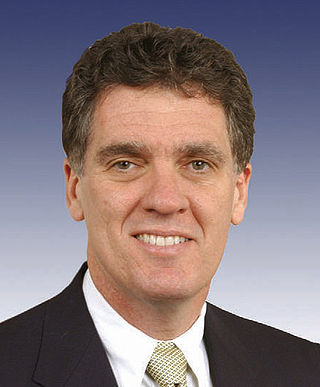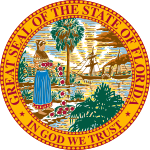
David Joseph Weldon is an American politician and physician. He was a Republican member of the United States House of Representatives, representing Florida's 15th congressional district, and was an unsuccessful candidate for the Republican nomination in Florida's 2012 U.S. Senate race.

Cornelius Alexander McGillicuddy III, also known as Connie Mack III, is an American former Republican politician. He served as a member of the United States House of Representatives from Florida from 1983 to 1989 and then as a Senator from 1989 to 2001. He served as chairperson of the Senate Republican Conference from 1997 to 2001.

The 1958 United States Senate elections were elections for the United States Senate which occurred in the middle of President Dwight D. Eisenhower's second term. Thirty-two seats of Class 1 were contested in regular elections, the new state of Alaska held its first Senate elections for its Class 2 and 3 seats, and two special elections were held to fill vacancies.

The 1952 United States Senate elections was an election for the United States Senate which coincided with the election of Dwight D. Eisenhower to the presidency by a large margin. The 32 Senate seats of Class 1 were contested in regular elections, and three special elections were held to fill vacancies. The Republicans took control of the Senate by managing to make a net gain of two seats. However, Wayne Morse (R-OR) became an independent forcing Republicans to rely on Vice President Richard Nixon's tie-breaking vote, although Republicans maintained a 48–47–1 plurality. Wayne Morse would caucus with the Republicans at the start of Congress’ second session on January 6, 1954 to allow the GOP to remain in control of the Senate. This was the third time, as well as second consecutive, in which a sitting Senate leader lost his seat.

The 1950 United States Senate elections occurred in the middle of Harry S. Truman's second term as president. The 32 seats of Class 3 were contested in regular elections, and four special elections were held to fill vacancies. As with most 20th-century second-term midterms, the party not holding the presidency made significant gains. The Republican opposition made a net gain of five seats, taking advantage of the Democratic administration's declining popularity during the Cold War and the aftermath of the Recession of 1949. The Democrats held a narrow 49-to-47-seat majority after the election. This was the first time since 1932 that the Senate majority leader lost his seat, and the only instance of the majority leader losing his seat while his party retained the majority.

The 1936 United States Senate elections coincided with the reelection of President Franklin D. Roosevelt. The 32 seats of Class 2 were contested in regular elections, and special elections were held to fill vacancies. The Great Depression continued and voters backed progressive candidates favoring Roosevelt's New Deal in races across the country. The Democrats gained 5 net seats during the election, and in combination with Democratic and Farmer–Labor interim appointments and the defection of George W. Norris from the Republican Party to become independent, the Republicans were reduced to 16 seats. Democrats gained a further two seats due to mid-term vacancies. The Democrats' 77 seats and their 62-seat majority remain their largest in history.

The 1932 United States Senate elections coincided with Democrat Franklin D. Roosevelt's landslide victory over incumbent Herbert Hoover in the presidential election. The 32 seats of Class 3 were contested in regular elections, and special elections were held to fill vacancies.

The 1868–69 United States House of Representatives elections were held on various dates in various states between June 1, 1868, and August 2, 1869. Each state set its own date for its elections to the House of Representatives before or after the first session of the 41st United States Congress convened on March 4, 1869. They coincided with the 1868 United States presidential election, which was won by Ulysses S. Grant. Elections were held for all 243 seats, representing 37 states. All of the former Confederate states were represented in Congress for the first time since they seceded from the Union.

The 1916 United States Senate elections were elections that coincided with the re-election of President Woodrow Wilson. This was the first election since the enactment of the Seventeenth Amendment that all 32 Class 1 senators were selected by direct or popular elections instead of state legislatures. Republicans gained a net of two seats from the Democrats, and then an additional two seats through mid-term vacancies thereby reducing Democrats to a 52–44 majority.

The 2004 United States Senate election in Maryland was held on November 2, 2004. Incumbent Democratic U.S. Senator Barbara Mikulski won re-election to a fourth term. This is the most recent time that a Democratic Senate candidate has won Allegeny County, Caroline County, St. Mary's County or Worcester County. This is the last time that the winning candidate carried a majority of Maryland's county-level jurisdictions in a United States Senate election in Maryland.

The 1976 United States Senate election in Florida was held on November 2, 1976. Incumbent Democratic U.S. Senator Lawton Chiles won re-election to a second term.

The 1932 United States Senate election in Maryland was held on November 8, 1932. Incumbent Democratic U.S. Senator Millard Tydings was re-elected to a second term in office, defeating Republican Wallace Williams.

The 1982 United States Senate election in New York was held on November 2, 1982. Incumbent Democratic U.S. Senator Daniel Patrick Moynihan won re-election to a second term.

The 1976 United States Senate election in New York was held on November 2, 1976. Incumbent Republican U.S. Senator James L. Buckley ran for re-election to a second term, but was defeated by Democratic diplomat Pat Moynihan. As of 2024, this is the last time an incumbent Senator from New York lost re-election to this seat.

The 1982 United States Senate election in Texas took place on November 2, 1982. Incumbent Democratic U.S. Senator Lloyd Bentsen won re-election to a third term in office, defeating Republican U.S. Representative James M. Collins.

The 1846 United States House of Representatives election in Florida was held on Monday, October 5, 1846 to elect the single United States Representative from the state of Florida, one from the state's single at-large congressional district, to represent Florida in the 30th Congress. The election coincided with the elections of other offices, including various state and local elections. The party primaries were held on June 20, 1846.

The 1942 United States Senate election in Texas was held on November 3, 1942. Incumbent Democratic U.S. Senator W. Lee "Pappy" O'Daniel was re-elected to a second term.

The 1928 United States Senate election in Florida was held on November 6, 1928.

The 1944 United States Senate election in North Carolina was held on November 7, 1944. Incumbent Democratic Senator Robert Rice Reynolds did not run for a third term in office. Former Governor of North Carolina Clyde R. Hoey won the open seat, defeating U.S. Representative Cameron A. Morrison in the Democratic primary and Republican attorney A.I. Ferree in the general election.

The 1944 United States Senate election in Maryland was held on November 7, 1944. Incumbent Democratic U.S. Senator Millard Tydings was re-elected to a fourth term in office over Republican Blanchard Randall Jr.























